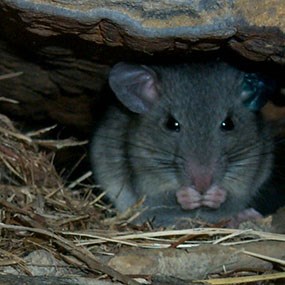
NPS photo The Allegheny woodrat is a small rodent (about the size of a squirrel) that resides in rock outcrops, boulder fields, abandoned mine portals, talus slopes, and caves from southern New York to Tennessee (Wood 2001). Woodrats prefer to inhabit cliff line or boulder fields with complex, small tunnel systems. This provides a secure "highway" between their food caches, latrines, and nesting site (NYSDEC 2012). Oftentimes, a rock ledge with discarded acorn shells can be an excellent indicator of Allegheny woodrat presence. A woodrat does not hibernate. Nearly midsummer, it starts to build a food cache for the long winter. Common predators of the Allegheny woodrat include great horned owls, black rat snakes, raccoons, and coyotes (Butchkoski 2010). Although related, the Allegheny woodrat differs from the more common, nonnative Norway and black rats in several ways: Unlike many animals, a trapped woodrat will rarely act aggressively towards its captors. Instead, it appears fearful, yet curious. Many times upon release, a woodrat will linger among the researchers, or will return within a few minutes to the release site. The Allegheny woodrat population is listed as a "species of concern" in West Virginia. Some factors that have contributed to its population declines are food shortages, increases in predator populations, raccoon roundworm, and general human encroachment. It is very likely that the chestnut blight that removed all of the old growth American chestnut trees had a widespread impact on the Allegheny woodrat food supply (Butchkoski 2010). It has a conservation status of at least an S3 (vulnerable) in the states of Alabama, Connecticut, DC, Indiana, Kentucky, Maryland, North Carolina, New Jersey, New York, Ohio, Pennsylvania, Tennessee, Virginia, and West Virginia (See distribution map; NatureServe 2012). The Allegheny woodrat has a global conservation status of G3 (vulnerable), which means "at moderate risk of extinction or elimination due to restricted range, relatively few populations, recent and widespread declines, or other factors." In addition to the global status, each state has its own relevant conservation status for the Allegheny woodrat (NatureServe 2012). If you are visiting potential Allegheny woodrat habitat, it is imperitive to pack out your trash and uneaten food scraps. Trash should never be left behind in any vicinity, but areas around the park's sandstone cliffs, boulder fields, abandoned mine portals, caves, and talus slopes need special consideration when it comes to Allegheny woodrat conservation. Leaving food debris and trash can attract scavengers that may prey on the woodrat, causing unneccesary interaction or introducing desease. For more information, visit the International Union for Conservation of Nature and Natural Resources website and search Allegheny woodrat (http://www.iucnredlist.org/details/full/14581/0). References Butchkoski E. 2010. Allegheny Woodrat [Internet]. Pennsylvania Game Commission; Linzey A, compiler. 2008. 2012 IUCN red list of threatened species, Neotoma magister [Internet]. IUCN; [cited 2013 Jan 3]. Available from: www.iucnredlist.org [NYSDEC] Department of Environmental Conservation, New York State. 2012. Allegheny Woodrat [Internet]. [cited 2012 Oct 1]. Available from: http://www.dec.ny.gov/animals/6975.html Wood P. 2001. Characteristics of Allegheny woodrat (Neotoma magister) habitat in the New Transcript
This is a juvenile male Allegheny Wood Rat. He has an ear tag; recaptured from the previous day. A fairly docile animal; if you don’t provoke them too much they won’t bite. You can see the ear tag in this ear right here; left ear; number one, number 649. A few flees. He’s like I said, a juvenile. We determine age class primarily by color and weight. However you can look at reproductive status as well and know whether it’s a juvenile. A very interesting animal. Fairly rare in the state and extinct in several portions of its range; New York and portions of Pennsylvania they’ve already lost populations; New Jersey; Indiana. A very unique animal. It differs from Norway rats by very long whiskers, long but blunt nose, hairy tail, and behavior. A Norway rat is a fairly aggressive animal – if it’s handled it will bite, whereas this animal is fairly docile, as I said before unless it’s greatly provoked it will not bite.
Visit our keyboard shortcuts docs for details
Join a park biologist to learn about the rare Allegheny Woodrat. |
Last updated: January 10, 2020
